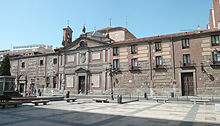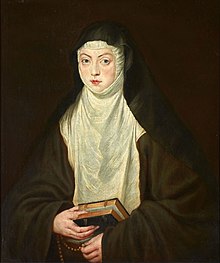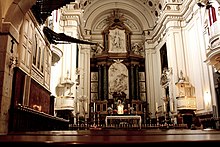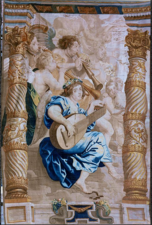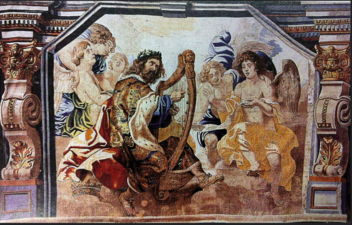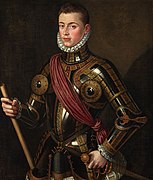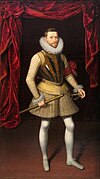Monasterio de las Descalzas Reales (Madrid)
The Monasterio de las Descalzas Reales ("Monastery of the Royal Discalced") in Madrid (also: de Nuestra Señora de la Visitación - " Our Lady of the Visitation ") is a nunnery of Clarissen (Colletinen) with a strict enclosure . It was founded in 1559 by Joan of Spain , daughter of Charles V , sister of Philip II of Spain , wife of the Infante Dom João Manuel of Portugal and mother of the last king of Portugal from the Avis dynasty , Dom Sebastião .
The Monasterio is located in the center of Madrid at the current Plaza de las Descalzas , near the Puerta del Sol . The building complex including the church from the 16th century houses significant art treasures and can partially be visited. The collections include numerous portraits and paintings by Brueghel, Cano , Correggio , Dolci , Giordano , Luini , Sebastiano del Piombo , Pontormo , Ribera , Rubens , Titian and Zurbarán .
The museum was awarded the Museum Prize of the Council of Europe in 1988 and is part of the Spanish Patrimonio Nacional .
history
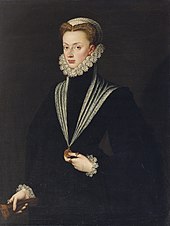
In the place of the current monastery there was originally an old palace, which was one of the first palaces in Madrid and, according to some researchers, dates back to the time of King Alfonso VI. declined; others consider him much younger. In the 13th century, the fort or Alcázar , of which the Fueros speak, served for defense and was not used as a residential palace. According to chronicles, the first Cortes in Madrid are said to have taken place here in 1339 .
In the 16th century, the old palace (possibly in a renewed form) belonged to the imperial treasurer Alonso Gutiérrez de Madrid , who housed Emperor Charles V here more than once. Several children of the emperor and his wife Isabella were born in this house , including the youngest daughter Johanna (Spanish: Juana de Austria , 1535–1573). She was married to the Portuguese heir to the throne, Dom João Manuel, and was widowed at a young age. She was temporarily appointed regent of the empire by her brother Philip II of Spain and founded the Monasterio de las Descalzas Reales at her birthplace.
1558 sent Francisco de Borja , Duke of Gandia , by the Convention of Saint Clara in Gandia a community of Colle Tinen here, in accordance with Padre Andrés Insulano, then general of the Franciscan Order . To Abbess Francisca de Jesus was elected, an aunt of the Duke of Gandia, but never lived in the convent of Madrid, as they are already in Valladolid died before the work was completed in the Convention. The second abbess never entered the new monastery either, as she died while the community was still living in Gutiérrez's house.

1559 to Assumption ( Asuncion ) the great celebration of the inauguration of the monastery took place, even though the church was not finished. Philip II and the entire royal family also took part in the solemn procession. The church was completed in 1564 and on the day of the Conception of the Virgin the Holy of Holies was deposited on the main altar.
In 1573 the founder of the monastery, Joan of Spain, died and was buried at her own request in the church of the Descalzas Reales.
In 1580 the monastery received Maria of Spain , the widow of Emperor Maximilian II , who came here with her thirteen-year-old daughter Margarita . From then on, the empress widow lived according to the rules of the monastery and her daughter entered the order. On April 22nd, 1602, Mary gave in the convent, together with the city council and the brothers of Atocha , a splendid three-day festival for the entertainment of King Philip III. to persuade him not to move the court to Valladolid; The king was pleased, but did not let himself be dissuaded from moving the court. Mary of Spain died on February 21, 1603 and, at her request, was buried at the feet of the Altar de la Oración del Huerto (“Of Prayer in the Garden ”) in the lower cloister, with a simple and plain stone tombstone. However, her body was discovered by Philip III 13 years later. transferred to a magnificent tomb made of marble and bronze under the choir of the church.

The important Spanish Renaissance composer Tomás Luis de Victoria (1540-1611) worked at the latest from 1587 until his death in August 1611 in the Monasterio de las Descalzas Reales, first as chaplain to the widowed empress Maria and later, from 1606, as organist . Other musicians who worked as organists or conductor of the Descalzas Reales were Joan March (from 1611), Cristóbal Galán (from 1667) and José de Nebra (from 1719).
The scope of the monastery complex was huge and, in addition to the church and the monastery outbuildings, also included a large vegetable garden. Over the years, women from the royal household and high nobility entered the monastery again and again and made important gifts and donations that made it a veritable treasure trove of works of art.
During the Spanish Civil War , the monastery was stripped of its community. However, it has been cared for and protected and its artwork has been carefully preserved. It was hit by a few bombs, which caused damage mainly to the staircase vault and destroyed the choir of the church. The restoration took place in the same war years, when, among other things, the dilapidated tile roof was replaced by a new one made of slate . After the war the nuns came back.
In the middle of the 20th century an underground car park was built under the Plaza de las Descalzas, which caused the building to suffer slightly. For this reason it has been restored and strengthened, and some of its outbuildings have been opened for tourist viewing. The whole project was directed and supervised by the Marquis de Lozoya , Minister of Fine Arts of the National Heritage ( Patrimonio Nacional ).
Inside are u. a. the remains of Alfons Jaime de Borbón y Dampierre, Duke of Cádiz , and of his son Francisco de Asís de Borbón Martínez Bordiu.
The Community

The first community of Colletine nuns came from Gandía in the province of Valencia to the Monasterio de las Descalzas Reales in Madrid. As mentioned above, they were sent here by Francisco de Borja in agreement with the General of the Franciscan Order. The first abbess Francisca de Jesús, aunt of de Borja, died in Valladolid before moving to Madrid. Her community and her coadjutors included Maria de Jesús - her eldest sister and daughter of the Marquis of Denia - Jerónima del Pesebre, Margarita de la Columna, Isabel de la Encarnación, and Ana de la Cruz. After the death of Francisca de Jesús, her sister María de Jesús took her place, who died in Madrid while the community was still in the house of the treasurer Alonso Gutiérrez, i.e. before the work on the monasteries was finished.
In 1559, on the day of the Assumption of Mary, the community of the Colletines finally entered the new monastery building in a solemn procession. In the course of history, various women of royal blood entered the Monasterio de las Descalzas Reales, apart from the aforementioned Joan of Spain and the Dowager Empress Maria of Spain :
- Margarita de Austria (1567–1633), daughter of Maria of Spain and Emperor Maximilian II , lived and died in the Monasterio.
- Anna Dorothea (1612–1694), an illegitimate daughter of Emperor Rudolph II , who took the habit at the age of 12 and died in 1694 at the age of 82.
- Caterina Maria d'Este (February 2, 1613, † 1628), daughter of Alfonso III. d'Este , Prince of Modena , and Isabella of Savoy (1591–1626), granddaughter of Infanta Catalina Micaela and Carlo Emanuele I of Savoy. Caterina Maria was dressed in 1622 at the age of 8 and died in 1628.
- Margarita de la Cruz, daughter of Juan José de Austria , paternal granddaughter of Philip IV and maternal of the painter José de Ribera . She entered the convent at the age of five and left the monastery on September 17, 1681, two years after her father's death.
- María de la Cruz y Austria , who died here in 1715 at the age of 74.
On September 3, 1715, Philip V issued a royal decree, by virtue of which all abbesses of the Descalzas Reales were given the title of Grande de España .
The building
The monastery with all its outbuildings originally took up a huge room, with a large plot of land for orchards, which reached up to today's Calle de Preciados and which was sold by the municipality in the 19th century; later a block was built there for the “ La Peninsular ” association. The gate of the church and the entrance to the monastery were on the square. Two other entrances were on Calle de la Misericordia and Calle Postigo de San Martín.
The church
The work of converting the old palace into a monastery was directed by the builder Diego Sillero , but the authorship of the church, which was completed in 1564, has been much debated. Traditionally it was attributed to Juan Bautista de Toledo , to whom the facade in the strict classical style could go back, where the classical column order was replaced by smooth surfaces, as in other works of Toledo. However, George Kubler pointed out that the church with a single nave covered by a barrel vault with lunettes can, according to his own testimony , be ascribed to the work of the Italian engineer Francesco Paciotto , who was called to Spain by Philip II to work on the construction of the Escorial . The steps of the altar , choir and sacristy were created in 1612 by Juan Gómez de Mora . Gaspar Becerra created the missing main altar in 1565 as the author of all of its architecture, paintings and sculptures. However, the architectural aspect of the interior today corresponds to the renovation that Diego de Villanueva undertook in the mid-18th century.
Main altar
In 1862 the church was the victim of a great fire that destroyed the altar by Gaspar Becerra , the paintings of the vault and portraits by Pantoja de la Cruz . The appearance of this altar is well known thanks to an architectural drawing preserved in the Biblioteca Nacional de España . In 1863 the Becerra altar was replaced by another, originally from the former Jesuit novitiate (on calle de San Bernardo and calle del Noviciado San Bernardo) and located in the Universidad Central from 1836 .
This altar was created in 1716 as a very unusual work for Spain in honor of the French Jesuit Jean François Régis , on behalf of Philip V and at the behest of his confessor, the French Jesuit Daubenton . For this purpose, six canvases on the life of Jean-François Régis were commissioned from the French chamber painter Michel-Ange Houasse .
The architectural setting and the sculptures of this altar, made of marble and gilded bronze, were also brought to the Descalzas Reales, as was the large relief of the Apotheosis of Jean-François Régis by Camillo Rusconi . For the sides, new sculptures have been created by the sculptor José Bellver y Collazos , more in line with the Franciscan order of the monastery: Francis of Assisi , St. Clare , Anthony of Padua , St. Dominic and other Franciscan saints.
Other works of art in the church
On the epistle side is the grave of the founder of the order, Princess Johanna, with a statue in prayer position made of white marble by Pompeo Leoni , in a small temple by Giacomo da Trezzo . Two side altars with paintings on marble by Gaspar Becerra, depicting John the Baptist and Saint Sebastian , patrons of the founder and her son Dom Sebastião, come from the original decoration . Also worth mentioning is a Immaculada Concepción , the Sebastian Herrera Barnuevo is attributed.
A panel of the Virgen del Milagro (“ Virgin of the Miracle ??”) by Paolo de San Leocadio from Reggio was placed on the high altar . This Madonna picture was originally kept in the Capilla del Milagro in the cloister (see below).
Antonio González Velázquez and his son Luís painted the vault that later burned in the fire of 1862. Antonio García restored it in 1863 and repainted it using a surviving drawing. Two portraits of the Dowager Empress Maria of Spain and her sister, the founder of the order, Princess Johanna, date from the same period in the presbytery ; these images replace the former portraits of Juan Pantoja de la Cruz , which were destroyed in the same fire.
Cloister
The cloister of the monastery (or patio de clausura ) is famous for the processions that take place there during Semana Santa , especially on Good Friday , when old music from the time of the founding of the monastery can be heard for the "Holy Burial" . There is a procession with a reclining Christ by Gaspar Becerra, who is carried on poles. For the occasion, rich liturgical vestments are worn (as in the Corpus Christi procession ) and on the walls of the four aisles of the cloister, some tapestries from the carpet series The Apotheosis of the Eucharist , made by the Flemish workshops of Jan Raes, Jacques Fobert, and Jacques Geubels, are hung and were designed by Rubens for the Infanta Isabella Clara Eugenia (a daughter of Philip II); she gave this to the Descalzas Reales on Thanksgiving in 1625 on the occasion of the Spanish victory at Breda. This series of tapestries is one of the most ambitious in the European Baroque and one of Rubens' main works. About half of them are shown in a permanent exhibition, where they hang in a room with high ceilings that was once the dormitory of the nuns before they got new cells. Rubens painted the templates for weaving the carpets on small-format panels, some of which are kept in the Prado . These designs were later transferred in original size by the master's assistants to cardboard boxes, some of which are on display in the Ringling Museum in Sarasota, USA.
- Carpet series Apotheosis of the Eucharist, based on designs by Rubens (selection)
The prophet Elias is nourished by an angel
King David with the harp
Caritas (charity)
After the recent restoration work, original elements of the cloister can be seen. Recent studies have shown that this courtyard was the core of the original home of Alonso Gutiérrez, from which many conclusions can be drawn about the original buildings and the architecture of Madrid in the 16th century. The patio underwent a first change in 1679 when the upper arcades were closed - probably for practical reasons as the building was known to be very cold. Under Charles III. the same thing happened on the lower floor in 1773, transforming the once open cloister into a closed gallery.
In a chapel in the upper cloister hung for centuries an Annunciation by Fra Angelico , a famous painting that was transferred to the Prado in 1862 after long negotiations by Federico de Madrazo , who was not only a painter but also the museum's director for many years. At the corners are four altars with panel paintings by Diego de Urbina , who was paid for it in 1586. Also noteworthy is a Virgin and Child by Bernardino Luini , a successor to Leonardo da Vinci .
There are sixty-six pieces of marble in the courtyard; the column shafts are cylindrical and slender and show an influence of Sevillian palaces which the owner of the (original) building, Alonso Gutiérrez, undoubtedly knew.
In the cloister are also the tombs of Alfonso and Gonzalo de Borbón y Dampierre and the eldest son of the first, Francisco de Asís.
Stairwell

The decoration of the large staircase with wall paintings and oil paintings on canvas comes from different eras. A royal balcony can be seen on the second floor, from which Philip IV , his second wife Maria Anna of Austria , Infanta Maria and Prince Felipe Prospero look down, suggesting that this detail must have been painted before 1661, the date of the prince's death . The painting of the Calvary on the first landing is attributed to Antonio Pereda and is believed to date from around the same time.
The last painterly intervention took place in 1684, when Claudio Coello and José Jiménez Donoso painted a series of archangels and created a mock architecture modeled on the Capilla del Milagro (see below). An inscription testifies to this work:
- Sister Anna Dorothea, Margravine of Austria, daughter of Emperor Rudolph II , nun of this monastery, had this staircase restored. Anno MDCLXXXIIII.

Capilla del Milagro
This chapel and its decoration were commissioned by Juan José de Austria , an illegitimate half-brother of Charles II (according to an inscription in situ ). An illegitimate daughter of Juan José lived here in the monastery, sister Margarita de la Cruz (1650–1686), a nun since 1666. The paintings al fresco and al secco are by Francisco Rizi and Dionisio Mantuano, who also run the so-called Casita de Nazaret (House of Nazareth ), a high point of 17th century Madrilenian illusion painting . In this chapel there used to be the tablet of the Virgen del Milagro (" Virgin of Miracles") by Paolo de San Leocadio, which is currently (as of 2018) on the main altar of the church.
- Paintings in the Monasterio de las Descalzas Reales, Madrid (selection)
Cristóvão de Morais : Dom Sebastião of Portugal , 1565
Anthonis Mor : Infanta Maria of Portugal , approx. 1550–1555
Alonso Sánchez Coello : Don Juan de Austria , 1567
Frans Pourbus d. J .: Archduke Albrecht VII of Austria , 1599–1600
Jooris van der Straaten: Elisabeth of Austria , Queen of France , ca.1573
literature
- Ramón de Mesonero Romanos: El antiguo Madrid, Primera parte , Madrid: Editorial Renacimiento, 1925. (Spanish)
- Pedro de Répide: El antiguo Madrid, Primera parte , Madrid: Editorial Afrodisio Aguado SA, 1981. ISBN 84-202-0001-8 . (Spanish)
- Ana Garcia Sanz & Maria Leticia Sanchez Hernandez: The Convents of Las Descalzas Reales and La Encarnacion (Two Cloistered Convents in Madrid) . Madrid: Patrimonio Nacional. 1999
- Joan Saunders: Convent of Las Descalzas Reales , articles on the website ringlingdocents from the Ringling Museum in Sarasota (seen on August 20, 2018) (USA), May 2007
- Elías Tormo: Las iglesias del antiguo Madrid , Editorial Instituto de España, 1985. ISBN 84-85559-01-0 . (Spanish)
- M. Ángeles Toajas Roger: Capiteles del primer Renacimiento en las Descalzas Reales de Madrid: Estudio del Patio del Tesorero . in: Anales de Historia del Arte 13 , 2003, pp. 97-130. ISSN 0214-6452. (Spanish)
Web links
Individual evidence
- ↑ a b c d e Joan Saunders: Convent of Las Descalzas Reales , articles on the website ringlingdocents from the Ringling Museum in Sarasota, May 2007 (seen on August 20, 2018).
- ↑ Original text in Spanish: “Restauro esta escalera Sor Ana Dorotea, Marquesa de Austria, hija del Emperador Rodolfo II, religiosa de este convento. Año MDCLXXXIIII. »
Coordinates: 40 ° 25 ′ 5.8 " N , 3 ° 42 ′ 22.3" W.
